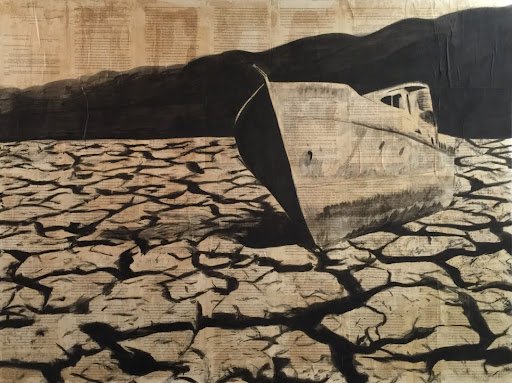California’s Aquifers at Risk
Salvador, J. (2015). California’s Water Crisis. photograph, https://www.artworksforchange.org/portfolio/jeremy-salvador/.
In the subterranean recesses beneath the state of California lies a vital arterial network—an ancient reservoir that has long served as a crucial water source for the region. These underground aquifers, formed over millennia, maintain an equilibrium between the intake and output of said water. Yet, In recent years, farming, population growth, and drought have altered this balance. California, a state famous for its droughts, finds itself approaching risk.
California produces 40% of the American intake of fruits, vegetables, and (most critically) nuts. Notably, this production comprises almost two percent of the nation’s economy – nearly $50 billion – and 14.7% of the agricultural wealth of the United States. A staggering 7.35% of the country’s nourishment stems from the Golden State, to say nothing of what California exports internationally.
Steve Jackson, a custodian of over 40,000 acres of fertile farmland in California, said, "I'd say 90 to 95 percent of our crop demands this year are going to be met by groundwater [water from aquifers]." With groundwater decreasing, this presents dire views of the future. ICalifornia is not just agriculturally self-sufficient; the state supports much of the nation, and more, which leaves California residents in a precarious situation. Without water, Los Angeles, California, and even America are destined to change. Currently we stand before a looming dust storm, so we as individuals must take action.
The truth is, California is running out of water, and whether the blame lies in the consumer or the farms, the answer is the same: we need to lessen water usage or find another source of water.
One proposed answer lies in nuts. Our water-stressed state produces 99% of the U.S.'s pistachios, 99% of the country's walnuts, and 82% of the world's almonds– some of the most water-intensive produce on the market. Although a blow to the economy now, stopping this production could save us down the line. The question is: is it worth it, or is this all just nuts?
Works Cited
California Department of Food and Agriculture. "California Agricultural Statistics." California Department of Food and Agriculture. Accessed October 27, 2023. https://www.cdfa.ca.gov/Statistics/#:~:text=Over%20a%20third%20of%20the,the%202022%20crop%20year%20are%3A&text=Dairy%20Products%2C%20Milk%20%E2%80%94%20%2410.40%20billion,Cattle%20and%20Calves%20%E2%80%94%20%243.63%20billion.
California Department of Water Resources. "Agricultural Water Use Efficiency." California Department of Water Resources. Accessed October 27, 2023. https://water.ca.gov/Programs/Water-Use-And-Efficiency/Agricultural-Water-Use-Efficiency.
California Water Commission. "Attachment 2: PPIC Fact Sheets." California Water Commission. June 2019. https://cwc.ca.gov/-/media/CWC-Website/Files/Documents/2019/06_June/June2019_Item_12_Attach_2_PPICFactSheets.pdf.
McEvers, Kelly. "Without Enough Water to Go Around, Farmers in California Are Exhausting Aquifers." NPR. July 22, 2021. https://www.npr.org/2021/07/22/1019483661/without-enough-water-to-go-around-farmers-in-California-are-exhausting-aquifers.
Pistachio production in California. Accessed November 10, 2023. https://apps1.cdfa.ca.gov/FertilizerResearch/docs/Pistachio_Production_CA.pdf.
Salvador, J. (2015). California’s Water Crisis. Photograph, https://www.artworksforchange.org/portfolio/jeremy-salvador/.
Walnut production in California. Accessed November 10, 2023. https://apps1.cdfa.ca.gov/FertilizerResearch/docs/Walnut_Production_CA.pdf.
Water Footprint Network – Water Footprint Network. Accessed November 10, 2023. https://www.waterfootprint.org/resources/Mekonnen-Hoekstra-2011-WaterFootprintCrops.pdf.
